Indulge in Danish Pastries: A Sweet Treat Guide
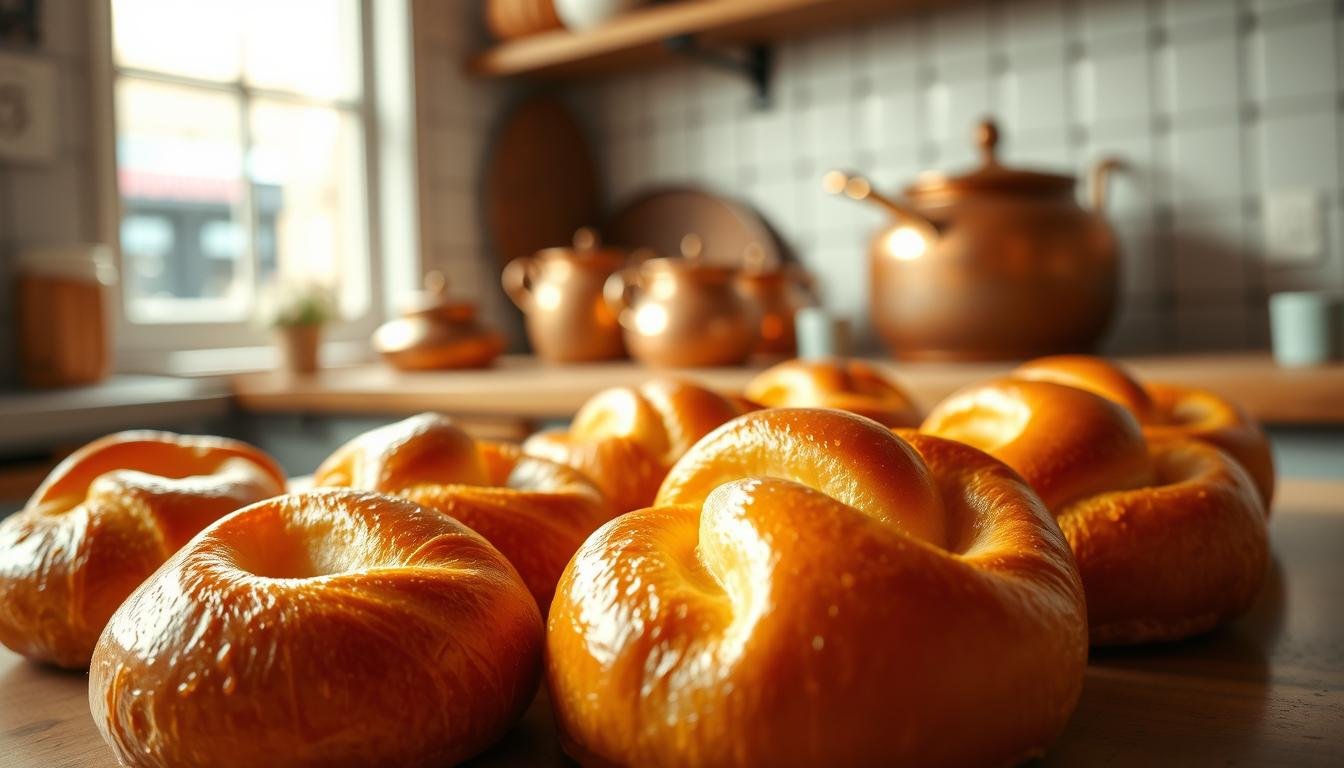
Ever wondered why Danish pastries are loved worldwide? Known as “wienerbrød” in Denmark, they are flaky and buttery. They offer a wide range of sweet treats, from cinnamon rolls to Fastelavnsboller.
Danish pastries started in the 19th century. Danish bakers created laminated dough for their flaky texture. This work and quality ingredients made them famous globally. Danish butter cookies are a big hit, loved as souvenirs and holiday treats.
Whether you love pastries or are just curious, Danish pastries have something for you. From the Kringle, which takes three days, to pancake balls in December, each pastry shares a piece of Danish culture.
Start your sweet adventure and see why over 10,000 travelers used the StoryHunt app in Copenhagen. You’ll enjoy a mix of flavors, textures, and cultural experiences. Danish pastries are a must-try for any food lover.
Key Takeaways
- Danish pastries originated in the 19th century with the introduction of laminated dough.
- Wienerbrød is the Danish term for these beloved pastries.
- Danish butter cookies are a popular export and souvenir from Denmark.
- Seasonal treats like Fastelavnsboller have cultural significance in Danish traditions.
- The Kringle, a complex pastry, requires three days of preparation.
- Danish pastries showcase a variety of flavors and textures, from flaky to creamy.
- These pastries have gained global popularity due to their quality and craftsmanship.
What Are Danish Pastries?
Danish pastries are a sweet treat from Scandinavian food. They are made with yeast dough, making them flaky and buttery. This dough is rolled, folded, and chilled 27 times.
A Brief History
In 1850, a bakery strike in Denmark led to Austrian bakers arriving. They brought new techniques that became the Danish pastry we love today. In Nordic countries, they are still called “wienerbrød” or Viennese bread.
Traditional Ingredients
Danish pastries have wheat flour, butter, milk, eggs, and sugar. The butter makes them rich in flavor. Some versions use hydrogenated oils instead of butter to save money.
Unique Characteristics
Danish pastries are special because of their dough. This dough has many thin layers of butter, making them light and flaky. They come in shapes like spirals and figure-eights. In the U.S., they are often topped with fruit or sweetened cream cheese.
| Feature | Danish Pastry | Other Pastries |
|---|---|---|
| Dough Type | Yeast-leavened, laminated | Varies (e.g., puff pastry, shortcrust) |
| Layers | 27 | Typically fewer |
| Key Ingredient | High butter content | Varies |
| Texture | Light, flaky | Ranges from dense to crisp |
Danish pastries symbolize hygge, the cozy comfort of Nordic food. They are loved worldwide for their taste and versatility.
Popular Types of Danish Pastries
Danish pastries are a sweet treat for everyone. They range from classic favorites to new twists. Let’s dive into the delicious options you can try.
Classic Varieties You Must Try
The kringle is a Danish favorite, shaped like a pretzel. It’s filled with nuts or fruit, great for sharing. Cinnamon rolls, or kanelsnegle, are loved for their cinnamon taste.
Cardamom buns have a unique flavor from the spice. Bear claws are filled with almond paste and sometimes fruit.
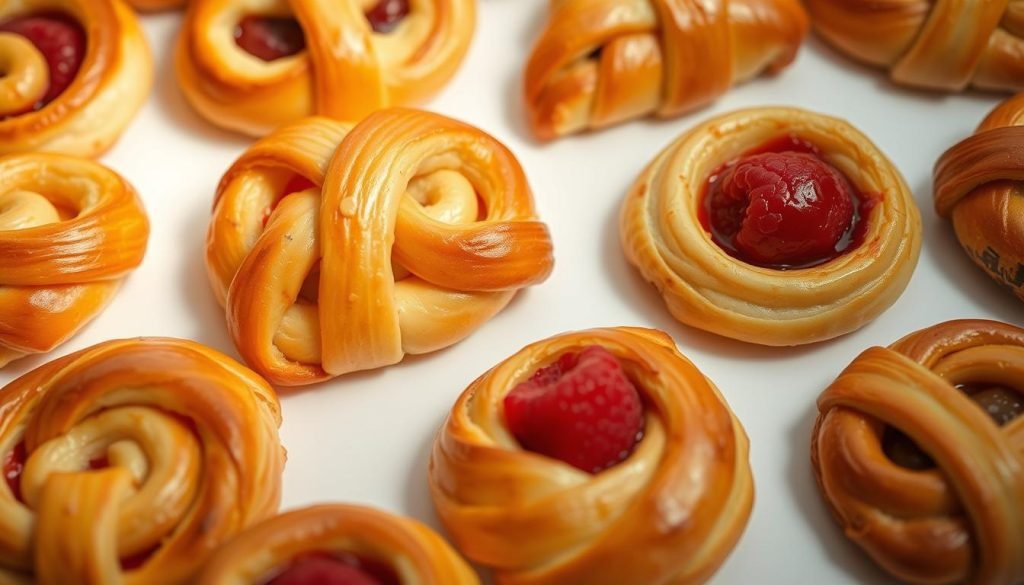
Modern Takes on Danish Pastries
Bakers are now mixing things up with Danish pastries. You can find flavors like matcha green tea or lavender honey. They even offer savory options with cheese or herbs.
Seasonal Flavors to Look Out For
Danish pastries change with the seasons. In spring, try rabarberhorns with rhubarb. Summer brings hindbærsnitter, raspberry slices with pink icing.
Fall has apple-filled pastries. Winter offers warm spices like ginger and nutmeg.
| Pastry | Description | Season |
|---|---|---|
| Kringle | Pretzel-shaped, filled with nuts or fruit | Year-round |
| Cinnamon Rolls | Spiral-shaped, cinnamon-flavored | Year-round |
| Cardamom Buns | Spiced with aromatic cardamom | Year-round |
| Bear Claws | Almond paste-filled, claw-shaped | Year-round |
| Rabarberhorns | Filled with rhubarb | Spring |
How to Enjoy Danish Pastries
Danish pastries are a treat for anyone who loves sweets. They go well with many drinks and can be enjoyed at any time. Let’s see how to enjoy these tasty treats.
Perfect Pairings: Beverages and Pastries
Choosing the right drink can make your Danish pastry experience better. Coffee is a top pick, matching well with treats like kanelsnegle (cinnamon snails) or spandauer. For something lighter, try tea with tebirkes, a Danish favorite filled with marzipan.
| Pastry | Recommended Beverage |
|---|---|
| Kanelsnegle | Strong black coffee |
| Spandauer | Latte or cappuccino |
| Tebirkes | Earl Grey tea |
| Hindbærsnitter | Fruit smoothie |
Best Times to Indulge in Danish Pastries
Danish pastries are great for any time, not just breakfast. In Denmark, morgenbrød (morning bread) is a favorite for breakfast. Some bakeries have special deals, like “Onsdagssnegle” (Wednesday snails), making midweek a perfect time to indulge.
Sharing Ideas for Gatherings and Events
Danish pastries are perfect for sharing at social events. Set up a pastry board with different kinds like medaljer, hindbærsnitter, and wienerbrød. This coffee cake alternative will wow your guests at brunches or afternoon teas. For big events, order a variety from local bakeries to show off the range of these sweet treats.
Remember, Danish pastries are more than food – they’re a cultural experience. So, invite your friends, make some coffee, and enjoy these delightful pastries together!
Where to Find the Best Danish Pastries
Danish pastries are a big deal in Danish cuisine. They come from the viennoiserie tradition. You can find these tasty treats in many places. Let’s look at where to get your hands on authentic Danish pastries.
Local Bakeries to Explore
In Copenhagen, you’ll find bakeries with amazing pastries all over the city. Vesterbro and Nørrebro are great for pastry fans. Skt Peders Bageri, the oldest bakery in Copenhagen, is known for its Onsdagsnegl, a special treat on Wednesdays.
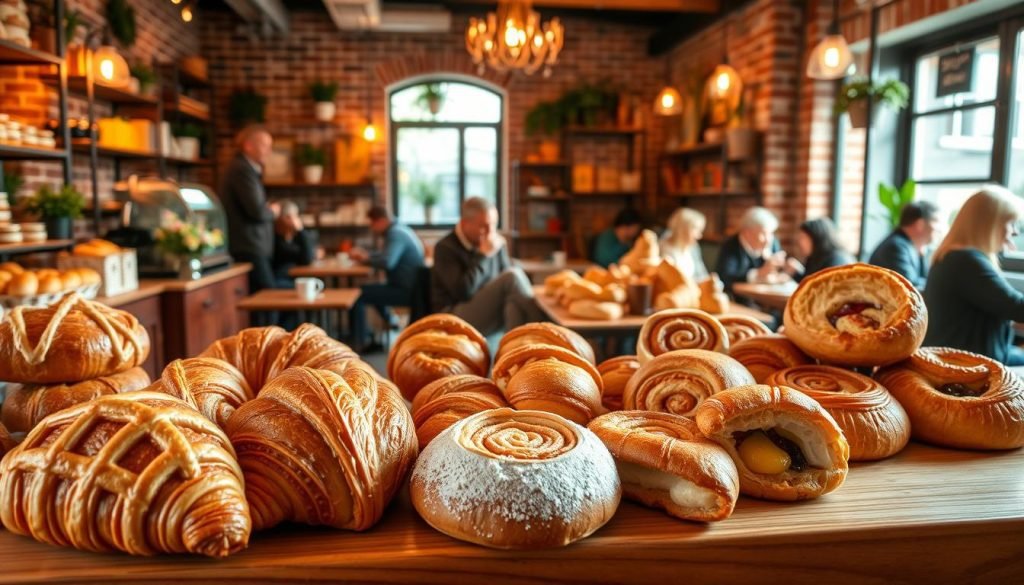
Online Shops Offering Delivery
Can’t visit Denmark? No problem! Online shops now deliver Danish pastries to your door. Enjoy real wienerbrød, spandauer, or tebirkes from home. Remember, fresh pastries taste the best.
Farmers’ Markets and Specialty Stores
Local farmers’ markets have artisanal bakers with Danish pastries. Specialty stores that focus on European or Scandinavian foods also have Danish pastries. Look for seasonal treats like fastelavnsboller or the cinnamon-filled snegl.
| Location | Popular Pastry | Special Feature |
|---|---|---|
| Copenhagen | Onsdagsnegl | Wednesday special at Skt Peders Bageri |
| South Jutland | Cake Table | 21 different cakes for events |
| Fyn | Brunsviger | Yeasty cake with brown sugar topping |
Making Danish Pastries at Home
Making Danish pastries at home is fun for baking fans. You need the right tools, ingredients, and skills. Let’s look at what you need and a simple recipe to try.
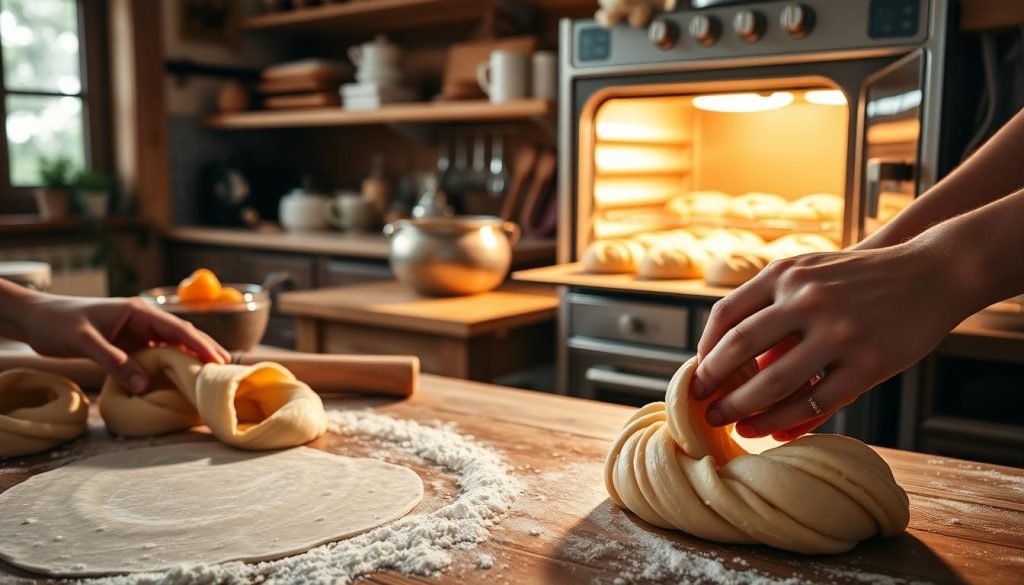
Essential Tools and Ingredients
To begin your Danish pastry journey, gather these items:
- Rolling pin
- Pastry brush
- Mixing bowls
- Baking sheets
- High-quality butter (226g for 390g flour)
- All-purpose flour (2 1/2 cups or 313g)
- Active dry yeast (2 1/4 teaspoons or 1 sachet)
- Sugar, milk, eggs, and salt
Step-by-Step Basic Recipe
Here’s a simple guide to make your Danish pastry dough:
- Activate yeast in warm water (100-110°F) for 10 minutes
- Mix dry ingredients, then add wet ingredients to form a dough
- Chill dough for 4 hours to overnight
- Roll out dough, layer with chilled grated butter
- Fold and roll dough three times, chilling between each fold
- Shape pastries and let rest for 30-60 minutes
- Bake at 400°F for 18-22 minutes until golden
Common Mistakes to Avoid
When baking, avoid these mistakes:
- Using warm butter (it should be cold)
- Overworking the dough
- Skipping resting periods
- Incorrect oven temperature
With practice, you’ll get better at making flaky Danish pastries. Remember, patience is key.
Healthier Alternatives to Traditional Danish Pastries
Craving Danish pastries but want to keep things light? You’re in luck! Let’s explore some tasty twists on classic pastry recipes. These will satisfy your sweet tooth without the guilt.

Substitution Tips for a Lighter Version
Try these smart swaps in your baking recipes to create healthier Danish pastries:
- Use reduced-fat cream cheese and non-fat Greek yogurt instead of full-fat versions
- Swap regular flour for whole wheat or almond flour
- Replace sugar with natural sweeteners like stevia or monk fruit
- Add vanilla protein powder for extra nutrition and flavor
Vegan Danish Pastry Recipes
Plant-based dessert lovers, rejoice! Vegan Danish pastries are possible and delicious. Use plant-based butter, dairy-free milk, and flax eggs in your pastry recipes. For fillings, try coconut cream or cashew-based cheese alternatives.
Gluten-Free Options for Everyone
Don’t let gluten sensitivities stop you from enjoying Danish pastries. Experiment with gluten-free flour blends in your baking recipes. Almond, rice, or tapioca flours work well for creating flaky, tender pastries that everyone can enjoy.
| Nutrient | Traditional Danish | Healthier Version |
|---|---|---|
| Calories | 374 kcal | 128 kcal |
| Total Fat | 20.3 g | 6.7 g |
| Carbohydrates | 37.2 g | 10.6 g |
| Protein | 5.7 g | 4.8 g |
With these healthier alternatives, you can enjoy Danish pastries guilt-free. Get creative in the kitchen and start baking your own delicious, lighter versions today!
Enjoying Danish Pastries in Different Cultures
Danish pastries are loved all over the world. They started in Scandinavian food traditions. Now, they’re part of celebrations and daily life everywhere.
Celebrations Featuring Danish Pastries
In Denmark, Danish pastries are a big hit at parties. The Fastelavnsboller, eaten before Lent, come in many flavors. In the US, they’re a favorite at holiday meals and office parties.
Danish Pastries Around the World
Danish pastries have traveled far. In the US, they’re called “Danish.” Germans call them “Copenhagener,” and in Denmark, they’re “Wienerbrød” or Vienna bread. This shows how they’re loved everywhere.

Fusion Treats: Mixing Cultures
Chefs around the world are making new Danish pastry creations. In Japan, they add matcha, and in Mexico, dulce de leche. These mix Danish baking with local tastes, making new flavors.
Danish pastries are loved everywhere. Whether in Copenhagen or New York, they bring a taste of Scandinavian culture to the world.
Pairing Danish Pastries with Cheese
Danish cuisine adds a fun twist by pairing pastries with cheese. This mix brings together great flavors. It will make your taste buds happy.
Types of Cheese That Complement Pastries
Soft and creamy cheeses pair well with Danish pastries. Cream cheese is a top pick for desserts. Mascarpone or ricotta add a rich taste without being too sweet.

Creating a Danish Pastry and Cheese Board
To make a great Danish pastry and cheese board, start with different pastries and cheeses. Include both sweet and savory options. Here’s a simple guide:
- Select 2-3 types of Danish pastries
- Choose 2-3 complementary cheeses
- Add fresh fruits like strawberries and raspberries
- Include a fruit spread, such as Bonne Maman INTENSE Red Fruits
Arrange your board nicely, with pastries and cheeses in a good pattern. Presentation is important. This unique twist on Danish cuisine will impress your guests.
The Art of Serving Danish Pastries
Presenting Danish pastries is an art that makes them even more enjoyable. Whether it’s a cozy breakfast or a fancy brunch, serving these desserts right will wow your guests.
Perfect Presentation Tips
To show off your pastries, use a tiered stand or a rustic wooden board. Arrange them in a pleasing pattern, mixing shapes and colors. Add fresh berries or edible flowers for a pop of color. The look of these treats is as important as their taste.
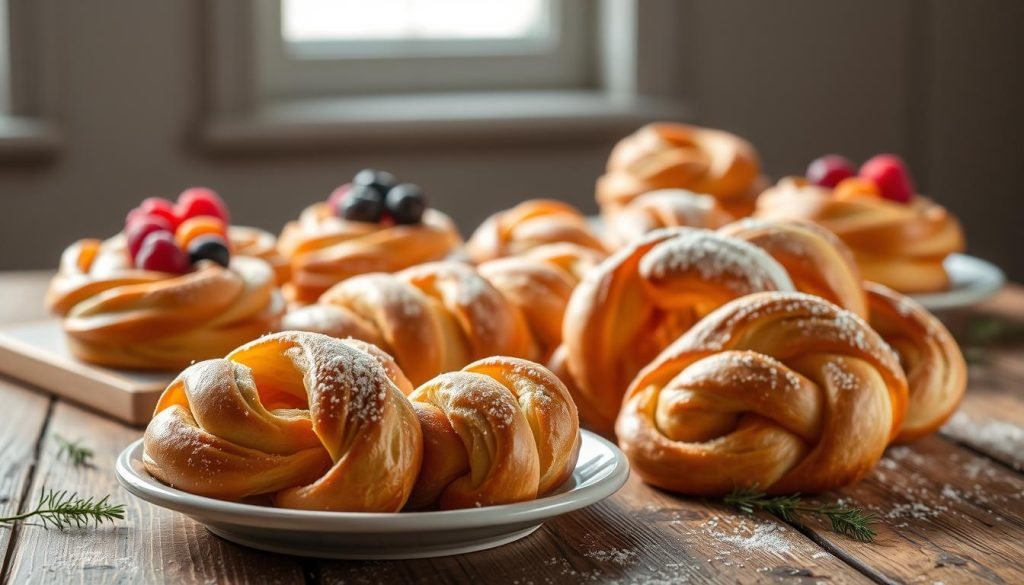
Serving Sizes and Suggestions
When serving, less is more. Danish pastries are rich, so give smaller portions. For a brunch, plan on 1-2 pastries per person. Pair them with fresh fruit or a light cheese to balance the sweetness.
- Serve pastries at room temperature for the best flavor and texture
- Offer a variety of pastries to cater to different tastes
- Include both classic and seasonal flavors in your selection
- Provide small plates and napkins for easy enjoyment
By mastering these serving techniques, you’ll create a memorable experience. Your guests will appreciate the care you’ve taken in presenting these beloved dessert recipes.
Storage Tips for Danish Pastries
Learning how to store Danish pastries is crucial. It helps you enjoy these tasty treats longer. The right storage keeps them fresh and tasty, whether you eat them now or later.
Keeping Your Pastries Fresh
The life of Danish pastries depends on how you store them. At room temperature, they last 1-2 days. In the fridge, they stay good for 5-7 days. Freezing is best for up to 2 months.
- Room temperature: 1-2 days
- Refrigerated: 5-7 days
- Frozen: Up to 2 months
To keep them fresh, wrap them well in plastic wrap or use airtight containers. This stops moisture loss and keeps them moist. Keep the fridge at 34°F to 38°F for best storage.

How to Reheat for Optimal Enjoyment
Reheating makes them taste like they just came out of the oven. Preheat your oven to 350°F (175°C). Then, warm them for 5-10 minutes. This method makes the pastry crispy on the outside and soft inside.
| Reheating Method | Time | Temperature |
|---|---|---|
| Oven | 5-10 minutes | 350°F (175°C) |
| Toaster Oven | 3-5 minutes | Low heat |
| Microwave | 10-15 seconds | High |
Pastries with fillings that spoil quickly should be eaten within a week in the fridge. Always check for mold or bad smells before eating your Danish pastries.
Sweeten Your Day with Danish Pastries: A Call to Action
Danish pastries are more than treats. They bring joy and share Danish culture. Their flaky texture and rich flavors make any day brighter.

Reasons to Treat Yourself Today
Enjoying Danish pastries boosts your mood. They come in many flavors, like cinnamon swirls and lemon Danish plaits. Over 69 million are eaten in the UK each year, showing their appeal.
- Enjoy a taste of tradition with popular varieties like Maple Pecan Plait
- Explore seasonal flavors such as Mango & Passion Fruit Danish Crown
- Try miniature versions for portion control without sacrificing taste
Finding Your Local Danish Pastry Spot
Finding authentic Danish pastries is easy. Local bakeries make them with love, using old recipes. Some add their own twist. Online shops also deliver them to you.
Enjoying a Danish pastry is more than just eating. It’s about enjoying a piece of art that mixes tradition and modern baking. So, treat yourself today and enjoy the mix of flaky layers, sweet fillings, and cultural heritage.
Wrap-Up: Your Danish Pastry Journey Awaits
Danish pastries are a sweet treat from Denmark. They can brighten your day in many ways. From flaky Wienerbrød to almond-filled treats, they show Denmark’s rich food history. Your adventure with Danish pastries is just starting, and there’s much more to discover.
Encouragement to Explore More Flavors
Don’t just try one type of Danish pastry. There are many varieties, each with its own adventure. Think about joining a pastry tasting tour in Copenhagen. You can try famous treats like Kringle and Hindbærsnitter.
These tours visit five top bakeries in two hours. They let you taste the best Danish pastries in the city.
Final Thoughts on Enjoying Danish Pastries
Indulging in Danish pastries is a special treat. You can enjoy them at a local bakery, try baking at home, or plan a trip to Denmark. Remember, these treats are more than food. They celebrate craftsmanship from the 19th century.
So, treat yourself to a Danish pastry today. Your taste buds will love this journey through Danish cuisine.